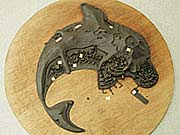Prerelease:Super Mario Sunshine
This page details prerelease information and/or media for Super Mario Sunshine.
To do:
|
Super Mario Sunshine went through a rather unusual development process, starting out as a search-and-rescue game before deciding to follow closer to the roots of its predecessor Super Mario 64. It notably had a number of changes under the hood, even to the point of where it hardly resembles the final product!
Despite the game having rather uneven difficulty and objectives, it is still enjoyable in many ways and kicked off the new generation of Super Mario games in 128-bit glory.
Contents
Development Timeline
2001
- May 18 - Shigeru Miyamoto promises new Mario and Zelda games at Space World 2001. He also wants to take Mario into a slightly older direction that would appeal to "all age ranges". [1]
- August 20 - Japanese magazine Nintendo Dream lists a release date of 2002 for the new Mario game.[2]
- August 22 - Super Mario Sunshine is first shown at Space World 2001, with release slated for Summer 2002.
2002
- March 25 - The game is confirmed for a North American release date of August 26, 2002.[3]
- March 30 - New footage of the game is shown exclusively to IGN.[1]
- May 2 - New screenshots are released.
- May 20 - The game is shown off at E3 2002.
- July 19 - Super Mario Sunshine is released in Japan.
- August 26 - Super Mario Sunshine is released in the United States.
Early Development
Creating a New Gameplay Element
When a follow-up to Super Mario 64 started development, the team tried to look for a new element that Mario could use while still retaining the gameplay. F.L.U.D.D. came to be when Koizumi first played with the GameCube controller, wondering what it would be like if it was used like a water pump, which was decided on without any thought put into it. Despite the unusual decision, he didn't worry about how it would turn out.
When conceptualizing F.L.U.D.D., Usui thought of him being held like a water gun at first, but he thought that it would have been mistaken for a real gun if the game ended up being released in the United States. Usui wasn't impressed with the final result and wanted to consider putting Yoshi on Mario's head that spits out water.
Ten different types of Nozzles for F.L.U.D.D. were considered, such as scrapped ones that would have resembled fireworks and sprinklers, but they were reduced to four because it would have been impossible to put them all in, and to avoid confusing players. The yield and usage of water from the nozzles were balanced until the very end of development in order to make it refreshing without being too direct or evasive.
The Hover Nozzle was originally the last unlockable Nozzle before eventually becoming the first, in order to make the game easier for Mario to navigate through high areas. The latter ended up being a rather difficult decision.
A More Realistic Setting
Koizumi wanted to create a setting that would evoke more detail than Super Mario 64, so he first thought of a "detailed townscape". As Usui had decided on a theme he drew rough sketches of a "villa on a plateau" and a "port town". Usui also wanted to make a specification sheet on a computer, but Koizumi ended up crafting the game's setting out of clay in order to verbally express it better, which would eventually be Isle Delfino.
A lot of discussions were held with the developers about the game's resort setting, so they studied photo books of them. Some of the staff had even visited resorts in South-eastern Asia. When designing the areas, they ended up being four times the size of those seen in Super Mario 64 due to the GameCube's expanded hardware. In order to further express the resort setting, Koizumi wanted to visualize Mario jump off the height of a three-story building while still emphasizing the expression unique to the game, so they could both match.
Yoshiaki Koizumi mentioned that the game was originally going to be based around disaster recovery[4], where Shine Sprite collection was not originally a main objective; this ties into unused dialogue trees involving a Mayor asking Mario for help dealing with crises in Delfino Plaza.
Sub-Pages
| 2001 The game makes its debut at Spaceworld 2001, having different... just about everything. |
| Pre-E3 2002 Still fairly different, but starting to resemble what would become the released game. |
| E3 2002 The builds shown at and around E3 2002. Finally starting to take shape. |
| Post-E3 2002 Adding the finishing touches. |
References
Help/Info Sources
- Super Mario Sunshine 2002 Developer Interviews - Shmuplations.com
- Interview with Shigeru Miyamoto, Takashi Tezuka, and Yoshiaki Koizumi - Gamecubicle.com
- Nintendo Online Magazine aka N.O.M interview - nsidr.com
